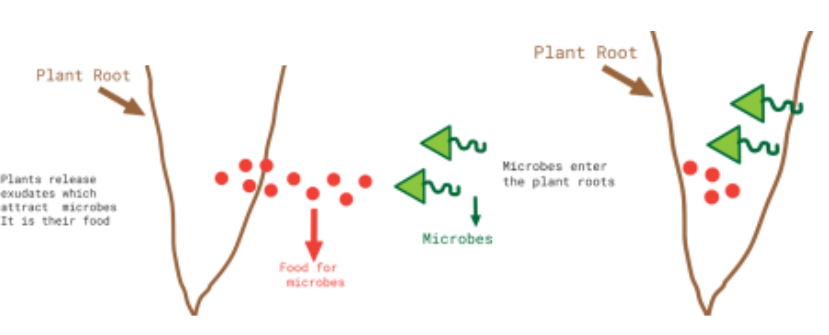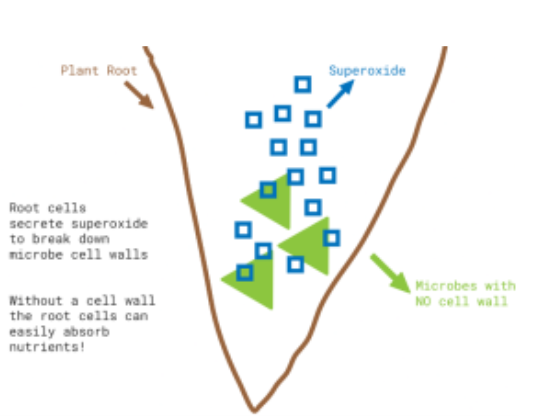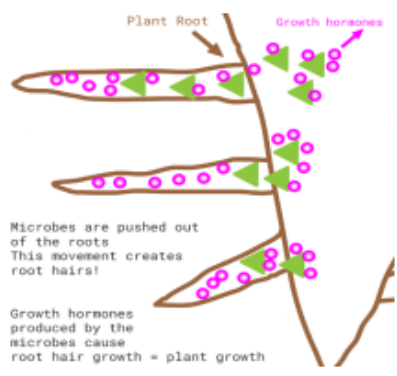What are endophytic bacteria, and how can they affect plant growth?
The role of endophytic bacteria in nutrient uptake and nitrogen fixation.
Why do microbes enter plant roots?
It is widely known and accepted that most plants obtain nutrients through two main pathways. The first pathway is directly absorbing dissolved inorganic nutrients from the soil. These nutrients, such as nitrates and phosphates, are essential for plant growth and survival. The second pathway is through the absorption of microbes. Microbes enter or otherwise get absorbed by plant tissues in the roots and aerial parts of plants. Nonpathogenic, meaning no harm-causing, microbes in plant tissues are called endophytes. This term refers to specific bacteria and fungi species. The roots are one of the most important parts of endophyte colonization in plants. Endophytes can also colonize the stems and the leaves; however, the most significant area of nutrient exchange happens at the tips of the roots (the meristem). This symbiosis between plant and microbe provides a range of benefits to the host. By promoting the growth of these endophytes, farmers can improve crop yields and reduce the use of chemical fertilizers and pesticides, thereby promoting sustainable agriculture practices. In this article, we will learn how farmers could increase endophyte populations in their crops, to benefit economically from this symbiosis.
Microbes help plants absorb nutrients – it would be impossible without them!
Are endophytes symbiotic?
Endophytes are endosymbionts. Endosymbionts are organisms that live within the cells or body of another organism, often forming a mutually beneficial relationship. They live within the plant for at least part of their life cycle without causing apparent disease. Endophytes alternate between a free-living phase in soil, in which they gather nutrients, and then they are attracted to root tips by exudates. Exudates act as bait to attract microbes (see STAGE 1). They are food for microbes, usually organic acids, amino acids, and sugars. Endophytes are ubiquitous and have been found in all species of plants studied to date; however, most of the endophyte/plant relationships are not well understood. Farmers can use this knowledge to select and breed crops that have a natural affinity for certain beneficial
endophytes. This can be accomplished through crop rotation, selecting crop varieties that are more receptive to endophyte colonization, and breeding for traits that promote
endophyte growth and function.
STAGE 1 STAGE 2 
Plants use exudates as bait to attract microbes!
What is the Rhizophagy theory?
Plants excrete superoxide to break down microbes and absorb their nutrients!
A relevant theory that explains how this happens is the so-called ‘Rhizophagy theory’. This theory suggests that once the endophytes enter the root cells (see STAGE 2), the plant secretes a chemical, called superoxide, to break down their cell walls. Thus, it’s easier to obtain their nutrients (see STAGE 3). Superoxide needs atmospheric oxygen to be formed, meaning that it is very important to maintain well-drained and aerated soil. The addition of organic matter into the soil creates these ideal conditions for microbial life to strive, whereas chemical fertilizers result in soil compaction and loss of microbial diversity. Recent studies have shown that there is more to it! Evidence suggests that, in fact, while endophytes obtain their source of energy, which is carbon, from plants, the roots obtain nutrients from the microbes. Most importantly, they also obtain nitrogen and acquire an enhanced oxidative
stress tolerance through a fascinating mechanism. The ‘Rhizophagy Cycle’ revised approach shows how plants reuse microbes after absorbing their nutrients to help them fix nitrogen.
STAGE 3

In this article, we will also explore the significant role of endophytes in nutrient uptake and nitrogen fixation. Understanding the complex mechanisms behind this process will help us increase plant growth and improve plant health. It will help us make informed decisions regarding agricultural practices and appreciate the importance of the organic matter in the soil.
Plant roots need well-aerated soil to uptake nutrients!
How does the plant grow root hairs?
During this nutrient cycle, endophytes play a key role in root hair formation. Root hairs are small, finger-like projections that extend from the surface of the root and increase the surface area available for nutrient uptake. Some endophytes are thought to help promote the formation of root hairs by triggering root growth and subsequent plant growth.
The remaining endophytes, the ones that did not get broken down by superoxide, due to the presence of antioxidants, are the ones that move further up the root tip. They are forced to exit the root. They exit the root by releasing growth hormones (see STAGE 4).
STAGE 4


Root hairs depend on such bacteria for growth. They frequently show no elongation unless bacteria are present within them. As endophytes exit the roots, they create root hairs. Plants cannot grow roots and root hairs without the presence of endophytes. Endophyte cell walls reform after exiting the root.
Microbes are necessary for root hair elongation!
Now we can understand the second part of the process in which the response of endophytes to superoxide also secretes nitric oxide from bacteria (see STAGE 5). Nitric oxide is an antioxidant that protects bacteria from damage. This suggests that, in most cases, antioxidant compounds are actually produced by endophytes and not by the plant itself!
Antioxidants are substances that can prevent or slow down damage to cells caused by free radicals, which are molecules produced when an organism breaks down food or when it is exposed to environmental stress. Free radicals can damage cells and contribute to plant disease and decreased growth. Some common examples of antioxidants include vitamin C, vitamin E, beta-carotene, and selenium. These substances are found in many foods, including fruits, vegetables, nuts, and seeds.
The more diverse the endophyte populations in arable soil, the healthier the crops since they depend on microbes for nutrient uptake and growth. Additionally, the more endophytes in crops, the better the nutritional value of the crop since it will contain higher amounts of antioxidants – the good things that make us healthy!
STAGE 5

This information helps farmers make the right decisions when it comes to preparing the soil mix for planting seedlings. Thus, it is very important to add organic matter, especially from composts, which already contain high amounts of beneficial microbes. These microbes will help crops grow and be healthy, reducing the need for chemical fertilizer and pesticide applications. If endophytes contribute to increased plant resistance to pathogens, then farmers can reduce the amount of pesticides they use. This results in significant economic benefits for farmers.
Antioxidants are mostly produced by microbes and not by the plants themselves!
How do plants obtain nitrogen?
This antioxidant, nitric oxide, transforms into nitrate using carbon dioxide, which as we all know, is naturally occurring in the atmosphere. Nitrate is absorbed directly into root cells. It is a chemical compound that contains nitrogen and oxygen, with the chemical formula NO3-. Nitrogen is an essential nutrient for plant growth as it is a key component of chlorophyll, which is responsible for photosynthesis and the production of energy for the plant. It is required for the formation of amino acids, nucleic acids, and other important cellular components. The amount of nitrogen in the soil can be limited, particularly in agricultural systems where the same crop is grown repeatedly. Endophytic bacteria can help alleviate this problem by converting atmospheric nitrogen into a form the plant can use, reducing the need for synthetic nitrogen fertilizers.
Endophytes reduce the need for nitrogen fertilizers!
Can microbes suppress plant disease?
Endophytic bacteria can also help suppress soil-borne pathogens, protecting their host plant from disease. Some endophytes produce toxic compounds to pathogenic fungi and bacteria, preventing them from infecting the plant. Other endophytes can induce systemic resistance
in the plant, stimulating its natural defense mechanisms and making it more resistant to disease. Farmers can also take steps to minimize the impact of harmful plant pathogens by promoting the growth of beneficial endophytes. This can be done by reducing tillage, avoiding the use of harsh pesticides, and promoting diverse crop rotations to reduce the buildup of harmful pathogens in the soil.
Endophytes can also protect plants from abiotic stresses such as drought and salinity. These stresses can negatively affect plant growth and productivity, but endophytes help the plant cope by producing compounds that protect it from stress.
What are the challenges of using endophytes in agriculture?
- Delivering endophytic bacteria to crops consistently and effectively has not yet been standardized. Although seed inoculation and foliar spray applications are the two main methods used to inoculate endophytes to crops, the efficiency of these methods can vary depending on the plant species, the bacterial strain used, and environmental factors.
- There are also regulatory challenges associated with the use of endophytes in agriculture. Microbes are living organisms, and their use may be subject to regulations governing the release of microbes into the environment. Therefore, additional research and regulatory frameworks are needed to ensure the safety and efficacy of endophytes in agricultural systems.
- Despite these challenges, the potential benefits of endophytes in crop roots are clear. These bacteria can help promote plant growth, suppress soil-borne pathogens, and protect plants from abiotic stresses. They have the potential to reduce the environmental impact of agriculture by reducing the need for synthetic fertilizers and pesticides. Rhizophagy symbiosis is a mutualism that involves the exchange of nutrients between the plant and microbe participants that benefits them both.
Farmers can benefit greatly from understanding the role of endophytes in plant growth and health. The benefit is mostly economical since endophytes reduce the need for synthetic fertilizers and pesticide applications. Studies have shown that even a 20% reduction in such applications results in enormous savings. But most importantly, it results in significant improvements in crop quality. This means healthier food for people and ultimately a healthier world!
By promoting the growth of beneficial endophytes and minimizing the impact of harmful pathogens, farmers can improve crop yields, reduce chemical inputs, and promote sustainable agriculture practices. Although challenges remain, the potential benefits of endophytic bacteria make them a promising area of research.
References
Paungfoo-Lonhienne, C.; Rentsch, D.; Robatzek, S.;Webb, R.I.; Sagulenko, E.; Näsholm, T.; Schmidt, S.; Lonhienne, T.G.A. Turning the table: Plants consume microbes as a source of nutrients. PLoS ONE 2010, 5, e0011915.
Chang, X.; Kingsley, K.L.; White, J.F. Chemical Interactions at the Interface of Plant Root Hair Cells and Intracellular Bacteria. Microorganisms 2021, 9, 1041. https://doi.org/10.3390/
Hardoim, P.R.; van Overbeek, L.S.; Berg, G.; Pirttilä, A.M.; Compant, S.; Campisano, A.; Döring, M.; Sessitsch, A. The hidden world within plants: Ecological and evolutionary considerations for defining functioning of microbial endophytes. Microbiol. Mol. Biol. Rev. 2015, 79, 293–320.
Verma, S.K.; Sahu, P.K.; Kumar, K.; Pal, G.; Gond, S.K.; Kharwar, R.N.; White, J.F. Endophyte roles in nutrient acquisition, root system architecture development and oxidative stress tolerance. J. Appl. Microbiol. 2021.
Foreman, J.; Demidchik, V.; Bothwell, J.H.F.; Mylona, P.; Miedema, H.; Angel Torres, M.; Linstead, P.; Costa, S.; Brownlee, C.; Jones, J.D.G.; et al. Reactive oxygen species produced by NADPH oxidase regulate plant cell growth. Nature 2013, 422, 442–446.
White, J.F.; Torres, M.S.; Somu, M.P.; Johnson, H.; Irizarry, I.; Chen, Q.; Zhang, N.; Walsh, E.; Tadych, M.; Bergen, M. Hydrogen peroxide staining to visualize intracellular bacterial infections of seedling root cells. Microsc. Res. Tech. 2014, 77, 566–573.
Macedo-Raygoza, G.M.; Valdez-Salas, B.; Prado, F.M.; Prieto, K.R.; Yamaguchi, L.F.; Kato, M.J.; Canto-Canché, B.B.; Carrillo- Beltrán, M.; Di Mascio, P.; White, J.F.; et al. Enterobacter cloacae, an endophyte that establishes a nutrient-transfer symbiosis with banana plants and protects against the black Ssgatoka pathogen. Front. Microbiol. 2019, 10, 1–15.
Verma, S.K.; Kharwar, R.N.; White, J.F. The role of seed-vectored endophytes in seedling development and establishment. Symbiosis 2019, 78, 107–113.










































































